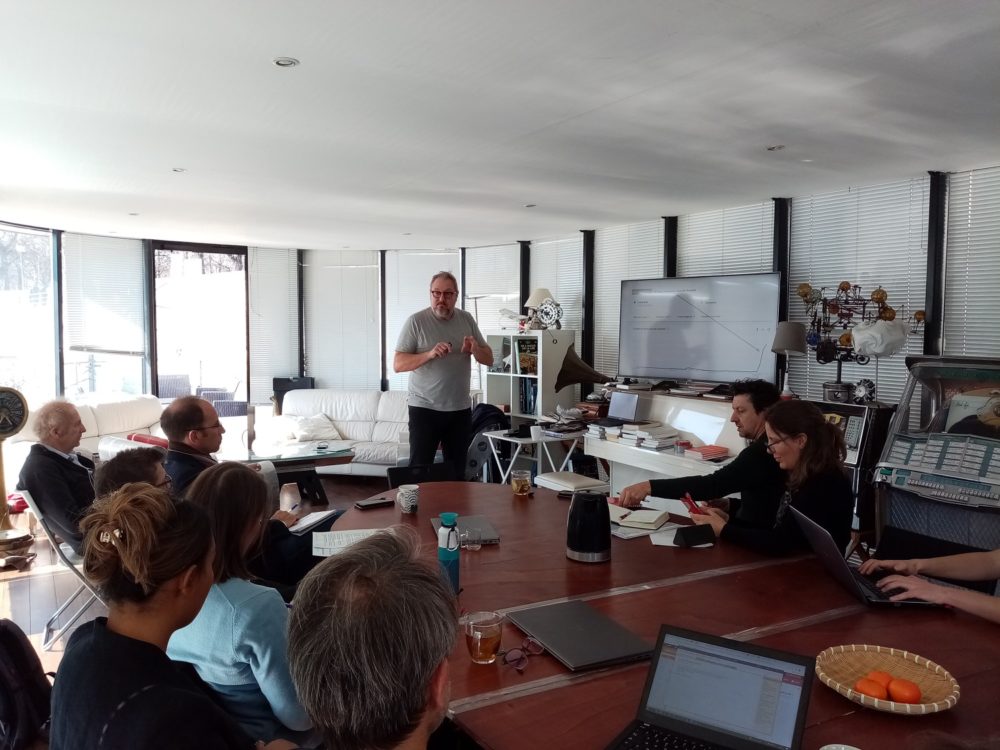Bertrand Wolff, Antilogy: The metaverse, a world under construction? – March 2022
Bertrand Wolff, Antilogy: The metaverse, a world under construction? – March 2022
by Lesley Brown & Joëlle Touré
Founded in 2017, Antilogy promotes the dissemination of immersive experiences. The company helps large corporations, institutions, and organisations gain the most from XR (‘extended reality’) when dealing with challenges linked to their digital transformation: how to better communicate, produce, sell, recruit, and train.
In March 2022, Futura-Mobility welcomed Bertrand Wolff, co-founder of Antilogy, for an immersion into the virtual world of the metaverse.

“The metaverse is like the internet except instead of being in front, we are within,” explains Mr Wolff. “It’s a development in the way data is used: we are no longer facing the data but are in the data.” This new world opens up the possiblity of teleporting into a virtual world for training (Stanford University is already offering a ‘metaverse experience’ course) or entertainment, to travel in time and space, to consume physical, digital or mixed objects, or to work.
What is behing this new buzz over the metaverse? Mr Wolff confirms, “search history on Google for the word metaverse comes up with nothing until October 2021… until the culmination of a series of announcements by Mark Zuckerberg.” Indeed, in the summer of 2021, the CEO of Facebook announced plans to make his social network platform the first “metaverse company” then, following a great many new job hires, on October 28 2021 he renamed the parent company ‘Meta’.
Hot on the heels of Mark Zuckerberg’s announcement, in November 2021, it was the turn of Satya Nadella, CEO of Microsoft, to announce his company was working on the metaverse. “However, unlike Meta, which is targeting both private and professional life, Microsoft is focusing on professional situations,” explains Mr Wolff. Like, for instance, allowing users of Microsoft Teams to create their own 3D digital avatars and work together in virtual spaces.
Also in November 2021, Dave Baszucki, cofounder and CEO of video gaming platform Roblox, points out how his company has already had the metaverse on its radar for 16 years! And that it is running it today! Roblox certainly does create connected and interactive social experiences, like concerts for instance, and so is already actively involved beyond the strict confines of the video gaming experience.
All these statements have led to speculation, especially real estate – like in The Sandbox, a virtual gaming space combining blockchain technology and NFTs (non fungible tokens).
Concentration of technologies
“The metaverse is a place where all the current technologies converge, like cloud computing, 5G, blockchain, artificial intelligence, headsets and the tools to gain access to this world,” confirms Mr Wolff. This convergence is the reason why virtual reality headset manufacturers have been bought up by big digital players: like Oculus by Facebook in 2014, or Pico Interactive by ByteDance (Tiktok) in 2021. As for Microsoft, it unveiled Hololens (hologramme technology for augmented reality) in 2015 and also around the same time time acquired Minecraft, most likely with convergence in mind.
“It’s important to realise that the smaller the devices – headsets for instance are getting smaller and smaller – the greater the cloud computing processing power needed, which is going to rely on 5G to transmit data,” explains Mr Wolff. The metaverse also needs 5G since its users will be in a virtual reality world, yet not necessarily in a room – they might move around in roaming mode, with augmented reality enriching the physical world where they are evolving.
Artificial intelligence will also be omnipresent in the metaverse: for universal translating, to recognise languages and enable the voice to become the main interface between man and machine. “Right now Meta is developing the world’s most powerful computer: 5 to 6 times more more powerful than the Japanese computer that is currently the fastest,” points out Mr Wolff. Today, Apple, Google, Microsoft, Meta, and Amazon are those investing the most in AI.
The user experience: addictive?
According to Mr Wolff, the media that is the virtual reality headset gives the impression there is no mediation. For the brain, the absence of media means it is reality. So the virtual reality headset creates an illusion of presence: the brain assimilates the journey as experience, just like in the physical world. The feeling and especially emotions are the same.
“Strange though it may seem, we don’t actually need a strong degree of realism in the metaverse to believe it,” expands Mr Wolff. “All that’s needed is a few basics and the brain does the rest. In this respect we are coming close to the uncanny valley theory.” In the latter, first published in 1970, a Japanese researcher demonstrated how the brain accepts images (in his experiment: a humanoid robot) better and better as the realism increases, up to a certain point, then this acceptance decreases all of a sudden before picking up again. In some metaverse worlds, the humans don’t have legs: a discovery that comes as a bit of a surprise at first, but then the user gets used to it very well!
“As the metaverse develops, users will be wanting greater comfort: wearing glasses on your nose or even contact lenses will be easier than a headset,” anticipates Mr Wolff. The company Mojo Vision, for instance, is already offering contact lenses that display data. Apple plans to launch its connected Apple Glass glasses at the end of 2022.
There is also criticism of motion sickness, the kind of sea sickness caused by virtual reality headsets that gamers may sometimes feel. It is due to the difference between visual perception and feelings from the body, and hence the inner ear that detects our stability. The body may react by vomiting because, ever since the emergence of Homo sapiens, feeling sick is an alert signalling that food hat might be dangerous been ingested.
Here Mr Wolff seeks to reassure: “Developers today are taking this issue into account quite well. For instance, to avoid this sickness in the metaverse, sudden movement mustn’t be imposed. During a fast movement forced on a user, their field of vision is reduced for several milliseconds.”
In 2018, Jason Rubin, working at the time for Oculus, shared a confidential report entitled ‘The Metaverse’ with certain directors at Facebook. In it he predicted that ‘in 20 years, we will be spending as much time in the metaverse as we did in front of the TV in the 90s, and do today on social media’. From this moment on, since 2018, Facebook (then Meta) really invested in the technologies to be able to offer a fully controlled environment.
Just as in real life or on social media, in the metaverse things develop even if we aren’t there… which is surely likely to lead to addictive behaviour!
Fashion, luxury, and even transport…
“The fashion and luxury industries are taking a keen interest in the metaverse since, with its avatars, it is the world of appearances par excellence,” analyses Mr Wolff. Brand means image: an association that has led to the emergence of B2A, Business to Avatars. On Roblox, for instance, Gucci has created Gucci Gardens where it has sold a virtual handbag for over $4,000 – more expensive than its physical version at $3,400! The Sandbox has sold a virtual yacht in Ethereum for around $650,000!
All the big brands are getting involved. In Nikeland – on Roblox too – fans of the brand can walk around, invent sports and buy branded items. It is interesting to see how the developers have totally freed themselves from reality for sports. Yet not all the initiatives are welcomed: when Heineken announced the launch of a new ‘virtual beer’ in its Decentraland virtual world, critics were somewhat divided!
Even in the transport industry some are venturing into the metaverse. “During CES 2022, Hyundai, which acquired Boston Dynamics in 2021, channelled its speech on the notion of metamobility,” explains Mr Wolff. According to the auto maker, this concept will enable robotics to bridge the gap between virtual worlds and the real. In Japan, railway operator JR East is building a metaverse of Akihabara train station, which serves a district in Tokyo considered the capital of Otaku (virtual community fans) culture.
Virgin territory… or almost?
As the metaverse takes shape, umpteen questions are being raised. The point of buying virtual goods, for instance. Mr Wolff explains how, in the metaverse, NFT technology guarantees the buyer is the sole owner of a virtual object: “if the neighbour has the same thing but not the guarantee, it means they’ve bought a copy. You can boast about having THE Gucci bag for your avatar, or an artwork.”
There are also sovereignty issues over this new territory. Who’s going to impose law? Who’s going to control this new monetary space? Who’s going to impose their culture? How to monetise the attention time of users or the level of emotions generated?
According to Mr Wolff, South Korea has been deploying soft power for years. Indeed, to have its own world and not depend on American or Chinese metaverses, in May 2021 the South Korean government announced its launch of the ‘Metaverse Alliance’, an industrial grouping that now includes 200 companies and institutions. The City of Seoul, which plans to invest around three million euros in the metaverse over five years, is undoubtedly a pioneer in the field.
In the US, there is ideology lurking behind the metaverse since some people are calling for Web 3.0, this decentralised web that escapes the stranglehold of the current internet giants (Google, Yahoo, Amazon, Meta…). Blockchain – technology for bypassing intermediaries when making transactions – ‘rebels’ are actively interested in this subject. They say that in the metaverse, blockchain would make it possible to do without the big platforms. And this is very much the issue at stake in the current race between today’s web and gaming giants, like Roblox, Meta, Microsoft and Apple: controlling the attention time of users to capture all the associated revenue.
There remain technology challenges like interoperability between compartmentalised worlds (or how to shift easily from a game in Roblox into Microsoft’s metaverse…), or hosting an unlimited number of people in a metaverse world – right now impossible.
Matthew Ball, a venture capitalist who has written a series of articles on the subject, imagines what the metaverse will be like in the future: “The Metaverse is a massively scaled and interoperable network of real-time rendered 3D virtual worlds which can be experienced synchronously and persistently by an effectively unlimited number of users with an individual sense of presence, and with continuity of data, such as identity, history, entitlements, objects, communications, and payments.”
The metaverse also raises questions over ethics, respect for diversity, or quite simply respect for others. Over time, will the metaverse betcome a new playground for trolls? Indeed, cases of sexual violence have already been reported.
Not to be ignored either, what about the ecological impact of the metaverse? Especially the massive dependence on rare earth and precious metals to produce the equipment and tools needed to support this new virtual world.
Outlook
As for the future of the metaverse, Mr Wolff cites Tim Sweeney, founder of video gaming studio Epic Games, “who says the idea of the metaverse is persuasive although he doesn’t quite see what it is! He says it won’t be the designers, be they Zuckerberg or Sweeney, who imagine the metaverse: users are going to make and shape the metaverse through the ways they use it.”



